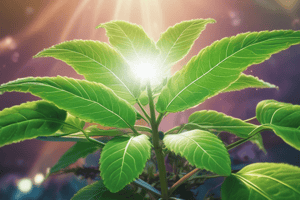Podcast
Questions and Answers
What is the pigment that absorbs light in plants and algae during photosynthesis?
What is the pigment that absorbs light in plants and algae during photosynthesis?
- Anthocyanin
- Carotene
- Xanthophyll
- Chlorophyll (correct)
Where do light reactions take place in photosynthesis?
Where do light reactions take place in photosynthesis?
- Cell wall
- Stroma
- Thylakoid membranes of chloroplasts (correct)
- Mitochondria
What is the primary product of light reactions in photosynthesis?
What is the primary product of light reactions in photosynthesis?
- Oxygen
- Carbon dioxide
- NADPH (correct)
- Glucose
Which photosystem absorbs light and splits water molecules during photosynthesis?
Which photosystem absorbs light and splits water molecules during photosynthesis?
In which part of the chloroplast do dark reactions (Calvin cycle) occur?
In which part of the chloroplast do dark reactions (Calvin cycle) occur?
What is the main purpose of dark reactions (Calvin cycle) in photosynthesis?
What is the main purpose of dark reactions (Calvin cycle) in photosynthesis?
What is the primary function of chlorophyll in photosynthesis?
What is the primary function of chlorophyll in photosynthesis?
During which stage of photosynthesis is carbon dioxide combined with ribulose-1,5-bisphosphate (RuBP)?
During which stage of photosynthesis is carbon dioxide combined with ribulose-1,5-bisphosphate (RuBP)?
What is the primary role of the light reactions in photosynthesis?
What is the primary role of the light reactions in photosynthesis?
Which component is regenerated for another cycle of carbon fixation in the Calvin cycle?
Which component is regenerated for another cycle of carbon fixation in the Calvin cycle?
What is the final byproduct of photosynthesis?
What is the final byproduct of photosynthesis?
Which stage of the Calvin cycle involves the conversion of 3-phosphoglycerate (3-PGA) into glyceraldehyde-3-phosphate (G3P)?
Which stage of the Calvin cycle involves the conversion of 3-phosphoglycerate (3-PGA) into glyceraldehyde-3-phosphate (G3P)?
Study Notes
Photosynthesis: The Life-Giving Process
Photosynthesis is a vital process that plants, algae, and some bacteria engage in, converting sunlight, water, and carbon dioxide into glucose and oxygen—the energy and life-giving elements that sustain life on Earth. Let's explore the intricate workings of photosynthesis as we delve into its key components: chlorophyll, light reactions, dark reactions, photosystems, and carbon fixation.
Chlorophyll: The Green Light
Chlorophyll is the pigment found in plants and algae that absorbs light, particularly blue and red light, to facilitate photosynthesis. Chlorophyll is often associated with green color, as it reflects green light, making plants appear green to our eyes.
Light Reactions: Energy Capture
Light reactions are the initial processes of photosynthesis, during which solar energy is captured and transformed into chemical energy in the form of adenosine triphosphate (ATP) and nicotinamide adenine dinucleotide phosphate (NADPH). This conversion happens in the thylakoid membranes of chloroplasts.
There are two photosystems: photosystem I and photosystem II, which work in concert. Photosystem II absorbs light and splits water molecules, releasing oxygen and protons. Photosystem I captures light and transfers energy to NADP+, converting it to NADPH.
Dark Reactions: Carbon Fixation
Dark reactions (or the Calvin cycle) occur in the stroma of chloroplasts and do not require light. During this phase, carbon dioxide is fixed into organic compounds using the energy stored in ATP and the NADPH generated during the light reactions. The resulting glucose is used as a source of energy for the plant, while oxygen is released as a byproduct.
Carbon Fixation: The Calvin Cycle
The Calvin cycle, also known as the light-independent reactions, is the process of incorporating carbon dioxide into organic molecules, forming glucose from carbon dioxide, ATP, and NADPH. The Calvin cycle can be divided into three main stages:
- Carbon fixation: Carbon dioxide is combined with ribulose-1,5-bisphosphate (RuBP) to form an unstable molecule, 3-phosphoglycerate (3-PGA).
- Reduction and regeneration: 3-PGA is converted into glyceraldehyde-3-phosphate (G3P), which is used in the next stage to produce glucose. RuBP is regenerated for another cycle of carbon fixation.
- Glucose production: G3P is combined with ATP and NADP+ to produce glucose and other simple sugars.
In summary, photosynthesis is a remarkably intricate process that involves capturing energy from sunlight, converting it into chemical energy, and fixing carbon dioxide into glucose, ultimately releasing oxygen as a byproduct. The process requires two photosystems, light and dark reactions, and chlorophyll as a pigment. Understanding these essential components and their roles in photosynthesis is fundamental to appreciating the intricate dance between Earth's living organisms and their environment.
Studying That Suits You
Use AI to generate personalized quizzes and flashcards to suit your learning preferences.
Description
Explore the intricate process of photosynthesis, where plants and organisms convert sunlight, water, and carbon dioxide into glucose and oxygen. Learn about chlorophyll, light reactions, dark reactions, photosystems, and carbon fixation in this essential biological process.




